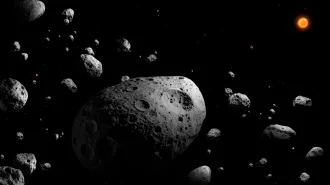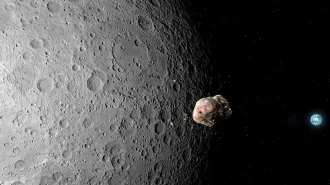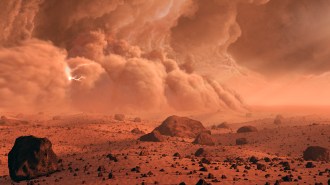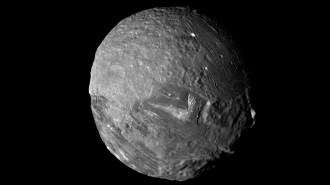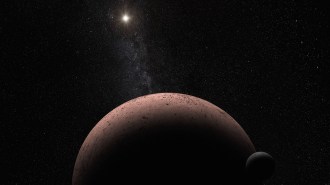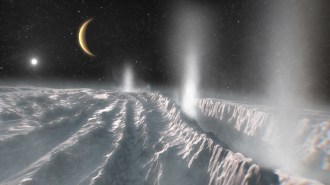New Horizons visited Pluto 10 years ago. We’re still learning from it
It's the only spacecraft that has flown by the distant dwarf planet

New Horizons flew by Pluto 10 years ago. Researchers are still unpacking the spacecraft’s insights on the distant, icy world.
NASA, JHU-APL
Planetary scientist Kelsi Singer was an undergraduate in 2006 when a spunky spacecraft launched with an ambitious goal: to fly by Pluto. It would take nearly a decade for the New Horizons probe to zoom past its target in the far reaches of the solar system.
“Oh, that’s so far off,” Singer thought at the time. “Nine and a half years to get to Pluto? That’s like forever.”
Now, Singer, who is deputy principal investigator for the New Horizons mission, and other scientists are celebrating the 10th anniversary of the spacecraft’s historic encounter with the beloved dwarf planet. New Horizons got within 12,500 kilometers of Pluto’s surface. Images and other data gathered during the flyby have transformed researchers’ understanding of the icy world.
“We all thought Pluto would be a little bit less interesting than we found it; we thought it would be more cold and dead,” says Singer, of the Southwest Research Institute in Boulder, Colo. “Since the flyby, we have basically rewritten the textbooks.”
New Horizons revealed a lively dwarf planet with traveling glaciers, ice volcanoes, an odd atmosphere and more. As the spacecraft hurtles toward interstellar space, researchers are still analyzing the riches plumbed from the Pluto flyby and figuring out why and how the distant world is such a fascinating place.
Over a decade of advocating for Pluto
Starting in the late 1980s, planetary scientist Alan Stern, also of the Southwest Research Institute, and other Pluto enthusiasts fought for the dwarf planet — then still considered a full-blown planet — to receive the same treatment as its kin. NASA spacecraft had visited all the other planets to study them by that point.
In 2001, Stern and his colleagues won a NASA competition to lead a Pluto mission, which took off five years later. The grand piano–sized New Horizons probe then traversed more than 5 billion kilometers over the next decade to get to Pluto, reaching its closest point on July 14, 2015.
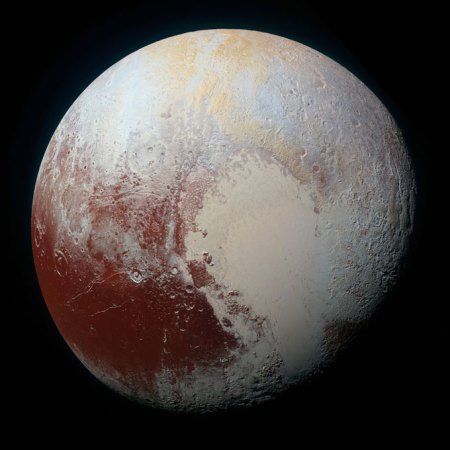
The spacecraft collected mountains of data with its seven instruments, including measurements on the composition of Pluto’s atmosphere and detailed images of the dwarf planet and its five moons.
Past snapshots of the ice-covered rock taken by the Hubble Space Telescope merely showed shaded blobs on the surface, Singer says. New Horizons exposed a whole new world.
Signs of a geologically active world
The spacecraft revealed what is now one of Pluto’s most famous features: a heart-shaped region roughly 1,600 kilometers wide. Its western lobe, called Sputnik Planitia, is a nitrogen glacier atop an ancient impact basin, says planetary scientist James Tuttle Keane of NASA’s Jet Propulsion Laboratory in Pasadena, Calif.
Sputnik Planitia’s location is special, he says. It sits at the equator and always faces away from Pluto’s largest moon, Charon, as the two bodies orbit each other, meaning there is probably something wonky going on with how mass is distributed across the planet.
Extra mass might be concentrated below the ice-covered basin. That mass is more likely to be a bulging liquid ocean than solid rock or ice, because that would let Pluto’s surface move around freely, ensuring Sputnik Planitia and Charon never come face-to-face. It’s similar to how a raw egg in its shell feels when spun compared with a hard-boiled egg, explains Keane, who uses computer simulations to explore the possibility.
If an ocean exists on Pluto, other bodies in the rock- and ice–filled Kuiper Belt might host oceans, too, Keane says. “That’s really interesting for understanding where habitable environments might be in the solar system, either today or in the distant past.”
Curious surface
Pluto hosts several landscape features that suggest the dwarf planet is far more geologically active than thought before the New Horizons spacecraft flew by in 2015.
-
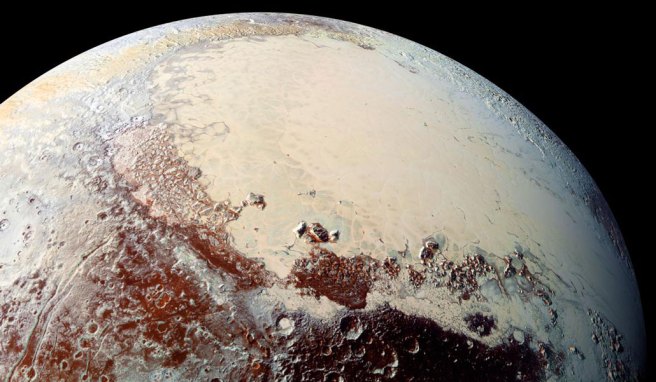
Sputnik Planitia (shown) is a sheet of nitrogen ice atop a basin. It makes up the western lobe of Pluto’s heart-shaped feature. JPL, NASA, JHU-APL, SwRI -
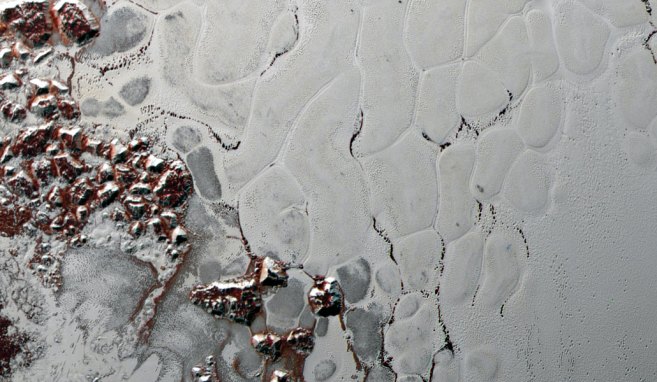
Sputnik Planitia’s surface sports a mottled pattern from material regularly rising and sinking due to a process called convection. JPL, NASA, JHU-APL, SwRI -
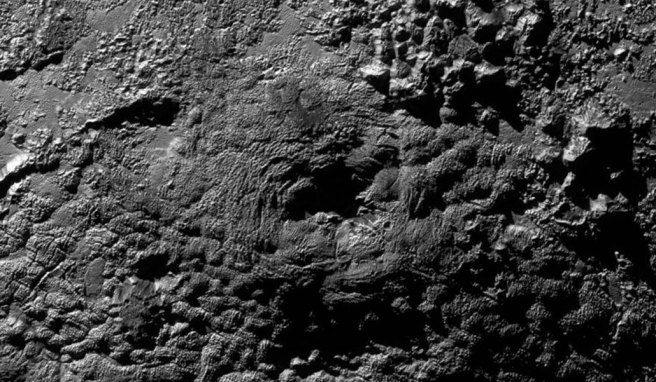
Volcanoes made of mostly water ice (one shown) may have spewed slush relatively recently. JPL, NASA, JHU-APL, SwRI
Other nitrogen ice glaciers dot Pluto’s surface as well, pooling downhill and leaving etched travel paths, Singer says. Her favorite features, however, are volcanoes of mostly water ice that may have spewed an icy slush relatively recently. Their presence suggests water ice is mobile on Pluto, she says, which is difficult to explain given the frigid temperatures of below –200° Celsius, far colder than water’s freezing point.
“It’s a special feature, not just because it’s really unique and we’ve never seen anything like it anywhere else in the solar system,” Singer says, “but because it implies this internal heat that is needed in order to be able to mobilize that material.”
Planetary scientist Bill McKinnon is looking into that heat. Specifically, he studies how heat is transported through Sputnik Planitia’s crust of nitrogen ice that is several kilometers thick. The surface sports a mottled appearance due to warmer material regularly rising and cooler material sinking. “We can see that it’s slowly overturning in a convective pattern, like slowly boiling oatmeal on your stove,” says McKinnon, a New Horizons team member at Washington University in St. Louis.
Solid nitrogen is soft and malleable, he says, allowing a planetary heating process that typically takes place underground to be on full display. But McKinnon and others are still figuring out nitrogen ice’s viscosity and other properties to understand convection on Pluto, which could provide insights into the dwarf planet’s geological evolution.
A hazy, layered atmosphere
The ground isn’t the only part of Pluto hosting oddities. The atmosphere is a bit bizarre, too.
It consists of mostly nitrogen, with smaller amounts of methane and carbon monoxide, all vaporized from the ices on the surface. But when the gases reach high in the atmosphere, sunlight-driven chemical reactions create a solid haze, similar to icy clouds, around the dwarf planet, says planetary scientist Tanguy Bertrand of the Paris Observatory.
“We are investigating how this haze forms, what is its composition, what are the chemical and physical pathways leading to formation of the haze,” among other questions, he says.
One planned line of research is why the haze splits into multiple layers. Bertrand suspects the layers are caused by waves in the atmosphere. These can stem from several sources, he says, such as wind blowing across landscape features or the regular sublimation and condensation of nitrogen on Pluto’s surface.
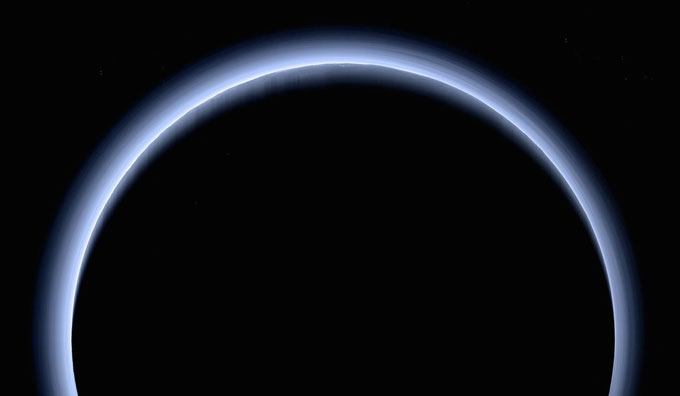
Moreover, the haze contributes to Pluto’s chilly climate, which Bertrand and his colleagues are figuring out how to best simulate. That will widen researchers’ understanding of how planetary atmospheres work and the chemical pathways that could lead to life on exoplanets, he says.
New Horizons could face a rocky future
While researchers have spent the past 10 years plundering Pluto’s riches exposed by New Horizons, the spacecraft has continued to chug along its linear path. It’s now about 9 billion kilometers from Earth. And it hasn’t stopped collecting data, including measuring the stream of charged particles from the sun, or solar wind, and counting space dust.
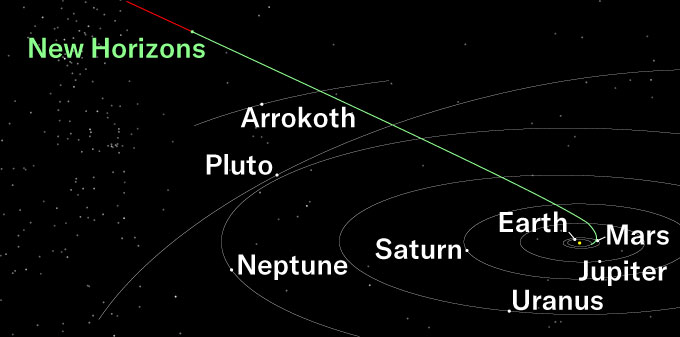
In 2019, the probe zipped by a distant Kuiper Belt object called Arrokoth. Its flattened snowman shape, likely a result of two bodies colliding, has helped researchers investigate how gas and dust clump and accumulate. Mission scientists are now looking for other objects that could get a flyby.
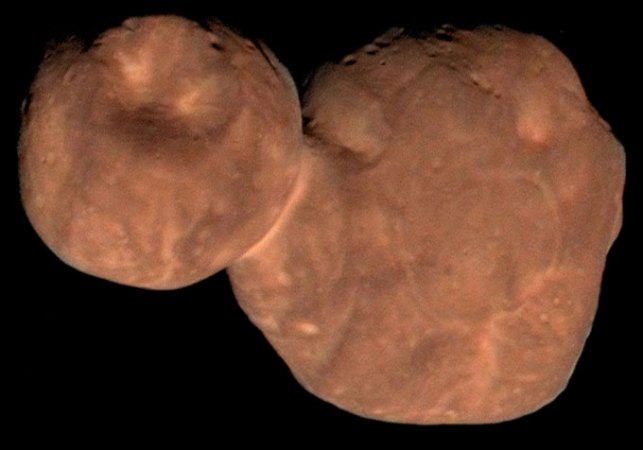
In the next few years, though, the New Horizons craft should reach the edge of the sun’s domain, entering an area dominated by the influence of other stars.
“This is a big deal for the heliophysics community, because [there are] not very many chances you have to cross this interface and learn about this protective bubble that we’re in,” Singer says. Only the Voyagers, both launched in 1977, have successfully reached interstellar space, and New Horizons’ scientific instruments surpass the older spacecrafts’ capabilities.
But New Horizons is one of nearly 20 active missions under threat of shutting down under the Trump administration’s proposed budget for fiscal year 2026, which includes drastic cuts to NASA’s scientific missions.
“These missions are 20-year endeavors, decades long to get going and have them up there,” says planetary scientist Fran Bagenal of the University of Colorado, Boulder, who previously led a New Horizons research team. “If you turn them off … you can’t get them back.” They are crucial not only for scientific discoveries but also for training the next generation of scientists, she notes. For instance, dozens of CU Boulder students have participated in designing, building, operating and analyzing data from the dust counter, providing research experience early on.
Singer believes New Horizons is a worthwhile scientific adventure with a bright future.
“All of our instruments in the spacecraft are perfectly healthy,” she says. “We are only halfway through our scientific lifetime.”
Who knows what New Horizons could uncover at the solar system’s edge and beyond in the next 10 years.
